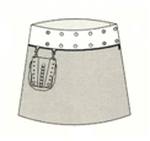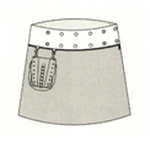
1. Hechos.
La sentencia del Tribunal de Dibujos y Modelos Comunitarios de 5 de febrero de 2015 viene a resolver el recurso de apelación interpuesto frente a la sentencia del Juzgado núm. 2 de Dibujos y Modelos Comunitarios de fecha 12 de septiembre de 2014. La sentencia recurrida estimaba la demanda interpuesta por Don Serafín y Don José Enrique frente a la mercantil Smash 2005 por infracción del modelo comunitario núm. 001720145-0001 aplicable a artículos de vestir de señoras, prendas y faldas por la comercialización por esta última de unos modelos de falda que producían, a su juicio, la misma impresión general que el diseño invocado. A su vez, el Juzgado desestimaba la reconvención de nulidad formulada de contrario por la demandada Smash 2005 frente al referido diseño comunitario basándose en que los modelos de falda divulgados con anterioridad no eran reversibles ni permitían varias combinaciones como así era en el caso del modelo impugnado, según aparecía explicado en la descripción del registro. En estas circunstancias, la demandada alza recurso de apelación ante el Tribunal de Dibujos y Modelos Comunitarios de Alicante.



2. Pronunciamientos.
El Tribunal de apelación comienza su análisis incidiendo en la importancia de diferenciar el diseño del producto, recordando que el objeto del derecho de exclusividad no es el producto sobre el que se asienta el diseño sino el registro en cuestión. Este inciso da pie al Tribunal a realizar un análisis en profundidad de cuáles son los elementos a considerar a la hora de realizar un examen comparativo para la determinación de la existencia de una infracción y, en definitiva, de cuál es el verdadero ámbito de protección de los diseños registrados.
En este sentido, para determinar cuáles son los elementos a considerar para determinar aspectos tales como el carácter singular de un diseño, el Tribunal parte de la base de que los requisitos más importantes del diseño registrado son la representación gráfica y la identificación del producto a que haya de aplicarse el diseño. Asimismo, señala, que mientras la identificación tiene como propósito “permitir a terceros que realicen búsquedas en las bases de datos de dibujos y modelos registrados”, la representación gráfica tendría por objeto “permitir que los terceros identifiquen con exactitud todos los pormenores del dibujo”, precisando que elementos como la indicación del producto o la descripción en el registro no deben afectar al alcance de la protección del diseño, que quedará limitado a la apariencia del producto, “tal cual resulte de su representación gráfica”.
Estos argumentos conducen al Tribunal a la conclusión de que la descripción del diseño escapa del ámbito de protección, de modo que rechaza así el razonamiento vertido en la sentencia recurrida, según el cual, los diseños divulgados con anterioridad diferirían del modelo comunitario impugnado porque no había constancia de que aquellos modelos de falda fuesen reversibles ni permitiesen varias combinaciones, tal y como se precisaba en la descripción contenida en el registro del modelo comunitario.
De este modo, la sentencia termina concluyendo que “lo relevante es la confrontación entre la representación gráfica de los dos diseños registrados, que revela su identidad; o entre la representación gráfica del diseño por el que se acciona y el diseño incorporado”. Y en vista de todo ello, estima el recurso y por ende la reconvención planteada.
3. Comentario.
La idea principal que se puede extraer de esta sentencia es que, sin perjuicio de que cabe la posibilidad de realizar aclaraciones por medio de una sencilla descripción en la solicitud, el ámbito de protección del diseño registrado quedará limitado finalmente a su apariencia y, en definitiva, a la representación gráfica que consta en el registro. No obstante, esta lectura puede resultar arriesgada, pues cabe preguntarse si el Tribunal de Dibujos y Modelos Comunitarios de Alicante hubiese llegado a la misma conclusión si, en lugar de tratarse de una descripción técnica o funcional del diseño, como sucede en el presente caso, hubiese sido en su lugar una descripción más bien estética, como por ejemplo, en diseños representados gráficamente en blanco y negro en los que la descripción puede incluso revelar los colores concretos del diseño. Existen casos, por tanto, en los que la descripción, a mi juicio, puede llegar a adquirir un papel trascendental en la determinación del ámbito de protección del diseño.
(Fuente de la información: ANUARIO ELZABURU 2015, recopilatorio de comentarios de jurisprudencia europea en materia de Derecho de Propiedad Industrial e Intelectual que realiza Elzaburu).
ENGLISH VERSION
The description of a design does not fall under the scope of protection. Judgment of the Community Trademark and Design Court of 5 February 2015.
1. Background.
This judgment resolves an appeal lodged against the decision issued by Community Trademark and Design Court no. 2 on 12 September 2014. In the appealed decision, the court had accepted a complaint filed by Mr. Serafín and Mr. José Enrique against the company Smash 2005 for infringement of Community design registration no. 001720145-0001 for women’s clothing, garments and skirts by the latter’s marketing of skirt designs which, in their view, produced the same overall impression as the design relied on. The Court dismissed Smash 2005’s counterclaim seeking the invalidation of the aforementioned Community design on the grounds that the previously disclosed skirt designs were not reversible; nor were different combinations possible, as was the case of the contested design, according to the explanation given in the description of the registration. In those circumstances, the defendant filed an appeal with the Community Trademark and Design Court in Alicante.



2. Findings.
The Appeal Court commenced its analysis by indicating the importance of differentiating between the design and the product. In that regard, it pointed out that the exclusive right refers not to the product to which the design is applied but to the registration concerned. This led the Court to conduct a comprehensive assessment of the factors to be taken into account when carrying out a comparative analysis for the purpose of determining whether infringement has occurred and, ultimately, to establish the actual scope of protection of registered designs.
In that regard, in order to determine which factors should be taken into account when establishing aspects such as a design’s individual character, the Court stated that the most important requirements for a registered design are the graphic representation and identification of the product to which the design is to be applied. It also pointed out that whilst the purpose of identification is to “enable third parties to search registered design databases”, the purpose of the graphic representation is to “enable third parties to accurately identify all the details of the design”. It specified that aspects of the registration such as indication of the product or the description should not affect the scope of protection of the design, which shall be limited to the appearance of the product “resulting from its graphic representation”.
Those arguments led the Court to consider that the description of the design does not fall under the scope of protection, and so it rejected the reasoning set forth in the appealed judgment, according to which the previously disclosed designs differed from the contested Community design because there was no evidence that those skirt designs were reversible or that they permitted various combinations, as specified in the description provided in the Community design registration.
The judgment therefore concluded that “what matters is the comparison between the graphic representation of the two registered designs, which reveals their identity; or between the graphic representation of the design as registered and the design incorporated into a product”. On that basis, the Court accepted the appeal and thus the counterclaim.
3. Remarks.
The main idea that can be extracted from this judgment is that, regardless of the fact that it is possible to provide clarification by means of a simple description in the application, the scope of protection of a registered design will ultimately be limited to its appearance and, essentially, to the graphic representation provided in the registration. However, such a reading could prove risky, since it has to be asked whether the Community Trademark and Design Court in Alicante would have arrived at the same conclusion had the case involved an aesthetic description, for instance, in designs that are graphically represented in black and white, where the description can even reveal the specific colours of the design, instead of the technical or functional description at issue here. There are therefore cases in which the description might come to play an essential role in establishing the scope of protection of designs.
ElDerecho.com no comparte necesariamente ni se responsabiliza de las opiniones expresadas por los autores o colaboradores de esta publicación








